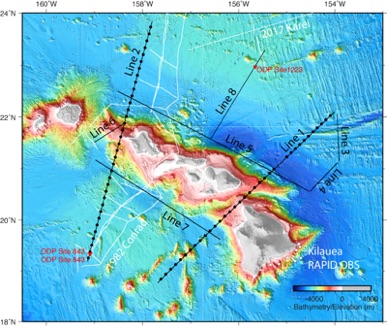Hawaiian-Emperor Seismic Experiment

Scientific motivation:
The Hawaiian-Emperor Seamount Chain is the most well-known example on Earth of hotspot magmatism, where volcanoes form above a hot region in the mantle, far from the boundaries between tectonic plates where most earthquakes and volcanoes are concentrated.
The chain of islands developed as the Pacific Plate moved slowly northwestward over the mantle hotspot (at a rate of ~51 km per million years). Today the Big Island of Hawaii is the most volcanically active, as dramatically shown by recent eruptions and earthquakes, and the islands to the northwest are successively older. As each volcanic island in the chain grew, the oceanic plate beneath warped under the weight of the new volcano, creating a trough of deeper water around the chain. After volcanic activity ceases, each island begins to erode, with older islands typically smaller due to longer exposure to erosion. A dramatic aspect of island erosion are massive submarine landslides that have scattered rubble across the neighboring ocean floor. Some of these are thought to have generated large pre-historical tsunamis. Earthquakes and more gentle slumping of the volcanic slopes can also generate small tsunamis - in 1868, for example, such an event claimed 46 lives.
Many questions remain about the fundamental earth processes that create the volcanoes of the Hawaii-Emperor chain and elsewhere, and how the enormous mass of these volcanos is supported by the oceanic plates below them. This study would involve seagoing expeditions to obtain critical information about the volume and composition of new crust formed from hot spot magmatism, how it varies along the island chain, and how the tectonic plate deforms in response to the weight of the volcanoes.
In addition, the study would provide a more comprehensive assessment of geohazards for the Hawaiian island region. Seismic data would image faults within the volcanic edifice and in the surrounding oceanic crust that could be used to evaluate seismic, tsunami and submarine landslide hazards.

Seismic data collection:
During two research cruises aboard the R/V Marcus G. Langseth in the fall 2019 and spring 2019, we acquired seismic reflection and refraction data on transects along and across the Hawaiian-Emperor Chain. Data were acquired with the seismic source and 15-km seismic streamer of the Langseth, and ocean bottom seismometers from Scripps, WHOI and GEOMAR. Cruise MGL1806 focused on the Hawaiian Ridge between the Big Island and Oahu. Cruise MGL1902 focused Suiko and Jimmu seamounts in the Emperor Seamount Chain.
Cruise MGL1806

Cruise MGL1902

